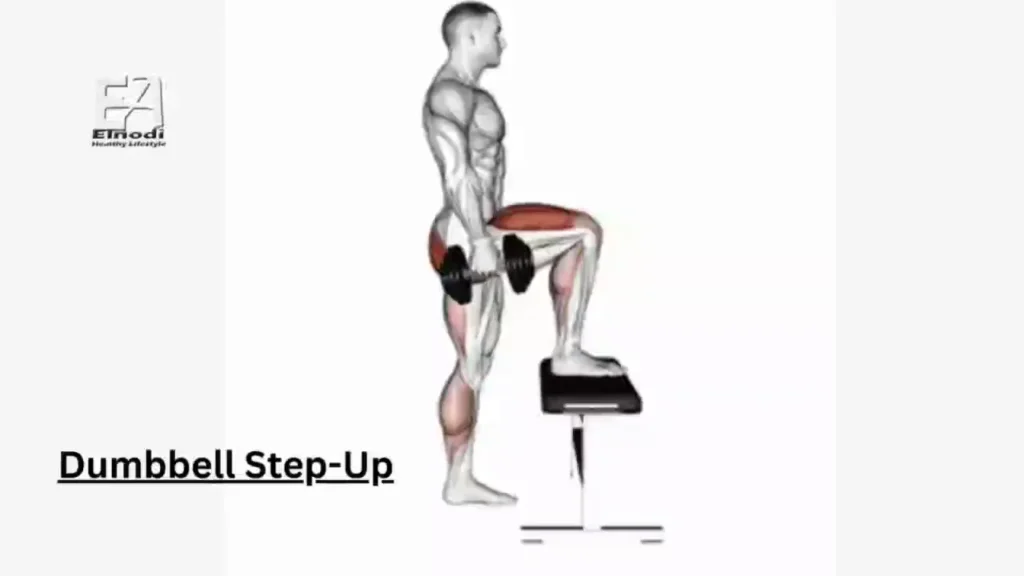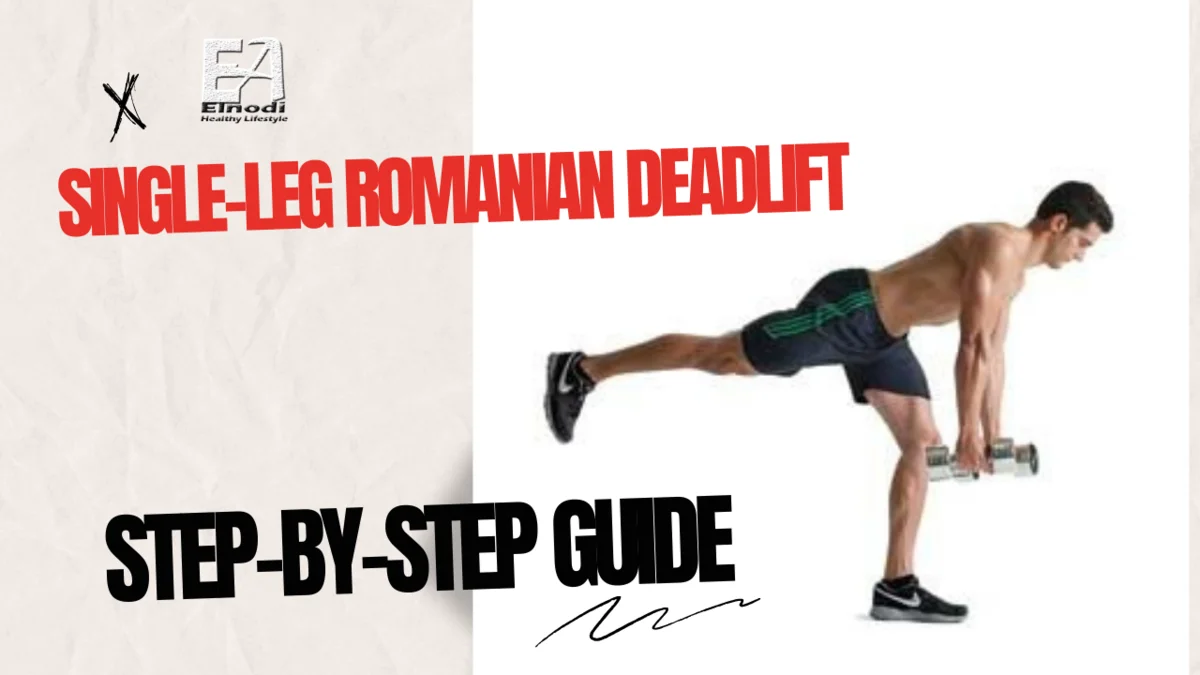The single-leg Romanian deadlift is one of the most common Deadlift variations. It starts with the lifter standing on one leg, with the other leg resting on the ground in front of them. They then extend their arm forward so that their hands are shoulder-width apart, and begin to deadlift the weight off the ground.
What is a Dumbbell Single-Leg Romanian Deadlift?
The single-leg Romanian deadlift is one of the best workouts you can practice at home or in the gym. Single-leg Romanian deadlifts, unlike many other exercises, improve your balance and build several posterior muscles. As a result, the workout enhances your gym performance, making you a better athlete, and promotes your ability to complete daily duties.
The purpose of single-leg Romanian deadlifts, as opposed to regular deadlifts, is to balance yourself on one leg while hingeing at the hip. Balancing is difficult, but frequent practice teaches you to stay stable more easily. Training one leg at a time is also beneficial for strengthening your glutes and hamstrings and increasing your mind-muscle connection.
As an accessory exercise, you should include the single-leg Romanian deadlift at the start or in the middle of your leg workouts. Avoid getting too tired before doing the activity because you will struggle to remain balanced.
Single-Leg Romanian Deadlift benefits
Correct Asymmetries: This unilateral deadlift variant, whether employed as a warm-up or a remedial exercise, will reveal any movement asymmetries between each side of the body. If an athlete has a disconnect that is producing hip shifting in the squat and/or pulls or has mobility limitations in one leg more than the other, re-teaching a fundamental action may be a suitable alternative. Finally, in locomotion sports (running and formal athletics), the mechanics of the lower limbs are often done with one leg (at most) being required to support the entire body throughout dynamic movement, making this an excellent exercise for movement disorders prevention.
Muscular Strength and Endurance: This unilateral deadlift variation is excellent for increasing hamstring and gluteal hypertrophy and endurance. Furthermore, this exercise can be incorporated into a training program to help beginners find and engage their hamstrings while limiting the amount of lumbar extension that occurs during most pulling and hip hinging (flexion and extension) motions.
Balance and Stability: The ankle, knee, hip, and spine must coordinate stable and dynamic movement throughout the movement in an unstable environment, making the complexity much harder than a standard Romanian deadlift. The added benefits of balance training, intrinsic foot coordination and strength, ankle and knee stabilization, and hip function make this a great exercise for assessing lower body balance and stability as well.
Application to Sport: This exercise may be used to strengthen movement patterning for practically every pulling movement, increase joint and movement integrity, and armor your body whether you are a weightlifter, powerlifter, strongman, fitness athlete, or formal sports athlete. including these in your training can be as simple as including them in your movement preparation, warm-up, or support work.
Single-leg Romanian Deadlift muscles worked

Primary muscles worked:
- Glutes
- Lower Back
- Hamstrings
Secondary muscles worked:
- Adductors
- Trapezium
- Forearm Flexors
Single-leg Romanian Deadlifts form
How to do Single Leg Romanian Deadlifts
- Balance on your right leg and grip a dumbbell in front of your thigh with your left hand.
- Allow your right knee to bend slightly and sit your hips back as if you were being pulled by a rope linked to your waist. Throughout the rep, your left leg should be straight (with a tiny bend in the knee) and in line with your body.
- Maintaining a flat back, bend at the waist until the dumbbell is about mid-shin height (this is ultimately dependent on your hamstring flexibility).
- To return to the beginning posture, drive through your heel and push your hips forward.
Tips
- Concentrate your attention on a fixed object around 10 feet in front of you.
- Create a double chin to set your neck.
- Tighten your grip on the dumbbell.
- When standing, flex your glute to increase your balance.
- Throughout the set, try not to touch your elevated foot to the ground.
- Before each rep, take a deep breath in and tense your core.
- Avoid curving your back as you lower the dumbbell, particularly as it approaches the ground.
- Straight down in a vertical line, lower the dumbbell.
Mistakes to Avoid
The most prevalent error with the single-leg Romanian deadlift is attempting it without prior deadlift experience. Learning to hinge at the hip is an important aspect of the Romanian deadlift, thus practicing it is beneficial. Begin with the basic hip hinge motion before balancing on one foot.
Allowing excessive back rounding is another fundamental flaw in the movement. Instead of pushing their buttocks back and loading their hamstrings, trainees frequently circle their lower back. Aside from not training the correct muscles, doing so places tremendous strain on your spine, resulting in back pain.
The third mistake to look out for is excessive knee flexion and extension. Many trainees bend their supporting legs as they lean forward and extend them as they stand up. Doing so makes the movement more unstable and shifts the tension toward the quadriceps. Avoid the mistake by maintaining a slight bend in your supporting knee throughout each set.
Another critical error is shortening the range of motion since it stops you from efficiently exercising the right muscles. Before getting up, you should bend forward until your torso is parallel to the floor. Anything less would make it impossible for you to efficiently lengthen and contract the posterior muscles.
Single-Leg Romanian Deadlift Variations
- Eccentric single-leg Romanian deadlift: This variation focuses on reducing weight during the eccentric phase of the exercise. Start in a standing stance with one leg extended behind you to do this variation. As you lower your body until your torso is parallel to the ground, hinge at the hips. At the bottom of the movement, pause briefly before making a gradual spin back to the starting position.
- Tempo single-leg Romanian deadlift: The exercise is performed at a moderate pace in this variation. You could, for example, count to two as you decrease the weight and then to two as you raise it. This variant can assist you in improving your form and concentrating on the functioning muscles.
- Rear-foot elevated single-leg Romanian deadlift: This variation is performed with your rear foot elevated on a box or bench. This helps to reduce the balance challenge and allows you to focus on loading the hamstrings and glutes.
Single-Leg Romanian Deadlift Alternatives
Single-leg glute bridge

This exercise works the same muscles as the single-leg Romanian deadlift but is a little easier. To begin, lay on your back with one knee bent and the other leg extended straight up. Raise your hips off the ground, forming a straight line from your shoulders to your knees. Hold for a second before slowly lowering your hips to the beginning position.
Single-leg Romanian deadlift kettlebell

The single-leg Romanian deadlift (RDL) with a kettlebell is a variation of the traditional RDL that is performed with one leg elevated. This variation is more challenging than the traditional RDL, but it also has more benefits.
Step-ups

This workout is excellent for strengthening your quadriceps, hamstrings, and glutes. To begin, stand in front of a step or bench with one foot on the step. Step up onto the step with your right leg, then step up next to it with your left foot. Return to the beginning position with your left leg, then repeat with your right.
How to do a single-leg Romanian deadlift bench
To perform the single-leg Romanian deadlift bench:
- Position a bench behind you, with the short end facing you.
- Place one foot on the bench and the other in front of you.
- Lower your torso until it is parallel to the ground, then hinge at the hips.
- Maintain a straight back and an engaged core.
- Take a brief pause at the bottom of the movement before slowly returning to your original position.
Single-leg Romanian deadlift vs. deadlift
The deadlift and the single-leg Romanian deadlift (RDL) are both excellent exercises for building the hamstrings, glutes, and core. There are, however, some significant distinctions between the two tasks.
The single-leg RDL is done with one leg elevated, whereas the deadlift is done with both feet on the ground. As a result, the single-leg RDL is a more difficult exercise since it demands greater balance and coordination.
The range of motion is another distinction between the two activities. The deadlift is executed in its entirety, from the floor to standing. The single-leg RDL, on the other hand, is often performed with a limited range of motion since maintaining balance with one leg elevated is more challenging.
| Characteristic | Single-leg RDL | Deadlift |
|---|---|---|
| Leg position | One leg elevated | Both feet planted on the ground |
| Range of motion | Shorter | Full |
| Unilateral vs bilateral | Unilateral | Bilateral |
| Difficulty | More challenging | Less challenging |
Summary
Exercises for unilateral training, such as the single-leg Romanian deadlift, can assist in promoting healthy movement patterns, joint integrity, and optimal muscle function during complicated motions. Never, especially in movement-based exercises like this one, should coaches or athletes compromise on movement mechanics in favor of loading.





